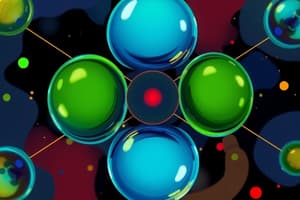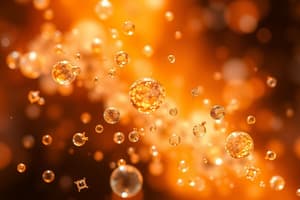Podcast
Questions and Answers
What is matter defined as?
What is matter defined as?
- Anything that has mass and occupies space. (correct)
- Anything that changes state under temperature variation.
- Anything that has density and volume.
- Anything that can be perceived by the senses.
Which of the following is NOT one of the main ideas of the particulate theory of matter?
Which of the following is NOT one of the main ideas of the particulate theory of matter?
- The particles are in constant, random motion.
- Particles can exist independently without any interaction. (correct)
- There are spaces between the particles.
- All matter is made of particles.
Why is the particulate theory of matter considered useful by scientists?
Why is the particulate theory of matter considered useful by scientists?
- It provides a historical perspective on matter.
- It directly relates to chemical reactions only.
- It can predict the weather accurately.
- It helps explain the physical properties and state differences of matter. (correct)
Which of the following correctly identifies the three main states of matter?
Which of the following correctly identifies the three main states of matter?
What happens to the state of a liquid when it is cooled sufficiently?
What happens to the state of a liquid when it is cooled sufficiently?
Which statement about the motion of particles is true?
Which statement about the motion of particles is true?
What characteristic of gas particles distinguishes them from those in solids?
What characteristic of gas particles distinguishes them from those in solids?
Which of the following explains why pebbles sink in water?
Which of the following explains why pebbles sink in water?
What do particles need in order to move towards each other according to the particulate theory of matter?
What do particles need in order to move towards each other according to the particulate theory of matter?
Which type of membrane allows certain substances to pass through while restricting others?
Which type of membrane allows certain substances to pass through while restricting others?
In the context of osmosis, what direction do water molecules typically move?
In the context of osmosis, what direction do water molecules typically move?
What happens to the volume of solutions when two different concentrations are separated by a differentially permeable membrane?
What happens to the volume of solutions when two different concentrations are separated by a differentially permeable membrane?
During the experiment using ammonia and hydrochloric acid, what observable phenomenon would indicate particle movement?
During the experiment using ammonia and hydrochloric acid, what observable phenomenon would indicate particle movement?
Which two substances are used in the experiment to demonstrate diffusion?
Which two substances are used in the experiment to demonstrate diffusion?
What is a key feature of a semi-permeable membrane relevant to osmosis?
What is a key feature of a semi-permeable membrane relevant to osmosis?
What type of activity might the teacher use to assess observation and reporting skills?
What type of activity might the teacher use to assess observation and reporting skills?
What defines the boiling point of a liquid?
What defines the boiling point of a liquid?
How does boiling differ from evaporation?
How does boiling differ from evaporation?
What happens to particles during condensation?
What happens to particles during condensation?
What is the freezing point of water?
What is the freezing point of water?
What characterizes sublimation in a substance?
What characterizes sublimation in a substance?
Which of the following substances is known to sublime?
Which of the following substances is known to sublime?
What occurs when the temperature of a liquid is lowered?
What occurs when the temperature of a liquid is lowered?
During the process of freezing, which statement is true?
During the process of freezing, which statement is true?
What is the primary difference between solids, liquids, and gases in terms of particle arrangement?
What is the primary difference between solids, liquids, and gases in terms of particle arrangement?
How does increasing the temperature of a substance affect its particles?
How does increasing the temperature of a substance affect its particles?
Why do certain insects appear to be able to walk on water?
Why do certain insects appear to be able to walk on water?
What occurs during a physical change of state?
What occurs during a physical change of state?
What effect does temperature have on the pressure of a gas?
What effect does temperature have on the pressure of a gas?
What distinguishes a liquid from a solid in terms of particle movement?
What distinguishes a liquid from a solid in terms of particle movement?
Why is the particulate theory of matter considered useful by scientists?
Why is the particulate theory of matter considered useful by scientists?
Which of the following statements correctly describes the gaseous state of matter?
Which of the following statements correctly describes the gaseous state of matter?
What happens to the potassium manganate(VII) crystal when it is placed in water?
What happens to the potassium manganate(VII) crystal when it is placed in water?
What is the result of the reaction between ammonia gas and hydrogen chloride gas in the glass tube?
What is the result of the reaction between ammonia gas and hydrogen chloride gas in the glass tube?
Why does ammonium chloride form closer to the cotton wool soaked in hydrochloric acid?
Why does ammonium chloride form closer to the cotton wool soaked in hydrochloric acid?
Which of the following best describes osmosis?
Which of the following best describes osmosis?
What were the two substances used at each end of the glass tube in the diffusion experiment?
What were the two substances used at each end of the glass tube in the diffusion experiment?
In the context of the diffusion experiment, what is meant by 'the particles collide'?
In the context of the diffusion experiment, what is meant by 'the particles collide'?
What is the expected observation after allowing the ammonia and hydrogen chloride vapors to diffuse in the glass tube?
What is the expected observation after allowing the ammonia and hydrogen chloride vapors to diffuse in the glass tube?
How does the distance between particles in water compare to that in potassium manganate(VII) crystals?
How does the distance between particles in water compare to that in potassium manganate(VII) crystals?
Flashcards are hidden until you start studying
Study Notes
Matter and its states
- Matter is anything that has mass and occupies space.
- Matter is made up of particles, according to the particulate theory of matter.
- All matter is made up of particles, which are in constant, random motion.
- The particles of matter have spaces between them.
- There are forces of attraction between the particles of matter.
- The strength of the forces of attraction between particles determines the state of matter.
- The three main states of matter are solid, liquid, and gas.
- The movement of the particles of matter determines the properties of the different states.
- Solids have the least amount of energy, the particles simply vibrate in their fixed positions and they are packed closely together.
- Liquids have medium amounts of energy, the particles move about slowly and have small spaces between them.
- Gases have the greatest amount of energy, the particles move about rapidly and have large spaces between them.
- The energy of the particles is directly related to the temperature, and matter can change its state by changing its temperature.
- Changing state by changing temperature is a physical change.
- A physical change occurs when the form of the substance is changed without changing its chemical composition.
Diffusion
- Diffusion is the movement of particles from a region of high concentration to a region of low concentration.
- The process of diffusion provides evidence for the particulate theory of matter.
- Diffusion can occur in solids, liquids and gases.
Osmosis
- Osmosis is a special case of diffusion, which involves the movement of water molecules through a differentially permeable membrane.
- A differentially permeable membrane is a membrane that allows some substances to pass through but not others.
- The cell membrane that surrounds biological cells is differentially permeable.
Boiling and Condensation
- Boiling is the constant temperature at which a liquid changes into a gas.
- Boiling occurs at a specific temperature.
- Boiling takes place throughout the liquid.
- Evaporation can take place at any temperature.
- Evaporation takes place only at the surface of the liquid.
- Condensation is the process where a gas changes into a liquid.
- Condensation occurs when the temperature of a gas is lowered.
Freezing and Melting
- Freezing is the process where a liquid changes into a solid.
- Freezing occurs when the temperature of a liquid is lowered.
- The temperature at which this occurs is called the freezing point.
- The freezing point of a pure substance has the same value as the melting point.
Sublimation
- Sublimation is the process where a solid changes directly into a gas or a gas to a solid, without passing through the liquid state.
- Substances which undergo sublimation include iodine, carbon dioxide, ammonium chloride and naphthalene.
Studying That Suits You
Use AI to generate personalized quizzes and flashcards to suit your learning preferences.




